Don't wanna be here? Send us removal request.
Text
The Best Day of the Year. Some Random Thoughts.
The Best Day of the Year. Some Random Thoughts.
Phew, I’m glad that’s all over for another year. Without a doubt, the best day of the year is Boxing Day. It’s a significant turning point in the Australian calendar, marking the start of summer holidays in earnest, a time to indulge in guilt free relaxation, simple foods, barbecues, books and trips to the beach. As much as I tried to avoid the Christmas mayhem this year, the gift giving…
View On WordPress
#Australian Christmas#Boxing Day#Christmas#king parrots#online shopping#peaches#shopping#St Stephen&039;s day
0 notes
Text
Have you ever noticed the cost of organic garlic? Australian organic garlic retails for around $30 or more a kilo ( €20/US$22). Other non organic garlic is a little less, while in the latter half of the year, the only garlic available commercially comes via Mexico and Argentina, which look a letter better than the snow-white mesh bags of Chinese bleached ‘garlic’. I would rather go garlic free than eat these nasty lumps of poison. If you love garlic, choose the best. Source seasonal garlic from a farmers market. Flavour and economy are two of the main reasons why I grow my own, but I have to admit, I love harvesting garlic and watching the early colours change from deep crimson and purple to a pale white striped with mauve after they dry. Beautiful bunches of garlic always remind me of country markets in France, alchemy, rustic food and good health. Long live garlic.

Early picked garlic, late October, not fully formed. Use like a spring onion, including the stem.
Growing garlic is time-consuming, which might explain why one head of organic garlic costs around $1.50. I’ll outline the steps here, in laywoman’s terms, for those who may be interested in growing a few. For those without a small patch of earth to dig around in, just enjoy this season’s garlic pics.

Early November. These garlic bulbs are beginning to show ridges under their outer purple casings. Still a bit small.
When to Plant
I usually start planting out cloves during Autumn, from late April to the end of May and do this in stages, thus staggering the final harvest dates. The old adage which advises that garlic must be planted by the shortest day, winter solstice, works as a rough guide, but I am finding that most of these old guides no longer work for me. If you leave your garlic till June 21st, expect a poor crop or none at all. The temperature of the earth is perfect for garlic in the last month of Autumn, providing just enough warmth to get green shoots going before winter. Given that garlic takes around 6-7 months to mature, it makes more sense to harvest them in late November, rather than during the busy December month. Last year I lost one bed of garlic planted in mid June and I can only put this down to the drop in ground temperature and the soggy soil. The little cloves rotted and vanished. Of course the timing of planting will vary from region to region. I live in a cool temperate zone. Tap into local knowledge to find the best time to plant in your own area.
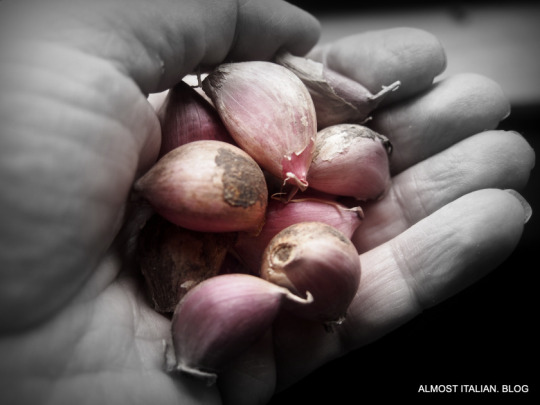
Planting Out
Choose your best looking cloves when planting. Keep some fine specimens from your previous harvest and plant these. If you choose little cloves, you will most likely produce little bulbs. The asexual reproduction of garlic means that what you plant is what you harvest, so choose your cloves wisely. It is said garlic reproduced in this way will eventually lose its vigour, and that one should revert to seed at some point, a process that takes years. I am yet to notice any loss of vigour in the plants at our current farm. Your soil needs to be fertile and friable. Hard clay isn’t suitable as the little bulbs need to expand easily. Push the flatter end of the cloves into the soil: the top or pointy end should be just below the surface. Plant cloves about 10 cm apart, in rows about 40 cm apart. It’s a good idea to mulch lightly over the soil once the green shoots appear. Organic sugar cane mulch works well. Given that your garlic will be in the ground for at least 6 months, you don’t want them having to compete with weeds for moisture and nutrition. If Winter and early Spring is dry, you’ll need to water the crop. Most of my crop was smaller than average this year. This was due to very low rainfall from late Winter to Spring when we were away and unable to water. Smaller bulbs still taste good but are tedious to peel. These little underground gems need watering just like any other plant. Towards harvest time, hold off watering.
Bulbil gems from the garlic stem
Garlic bulbils
Garlic Bulbils 2018
Garlic bulbils
Harvesting
Harvesting occurs when the stalks begin to dry out and seed pods form at the top. I usually dig out a few in early November and start eating the immature specimens, the stalk included. By digging them up occasionally, you’ll be able to gauge their development. If you leave them too long, the cloves begin to separate and open like a flower: while still tasty, these don’t store as well as tightly closed garlic bulbs.
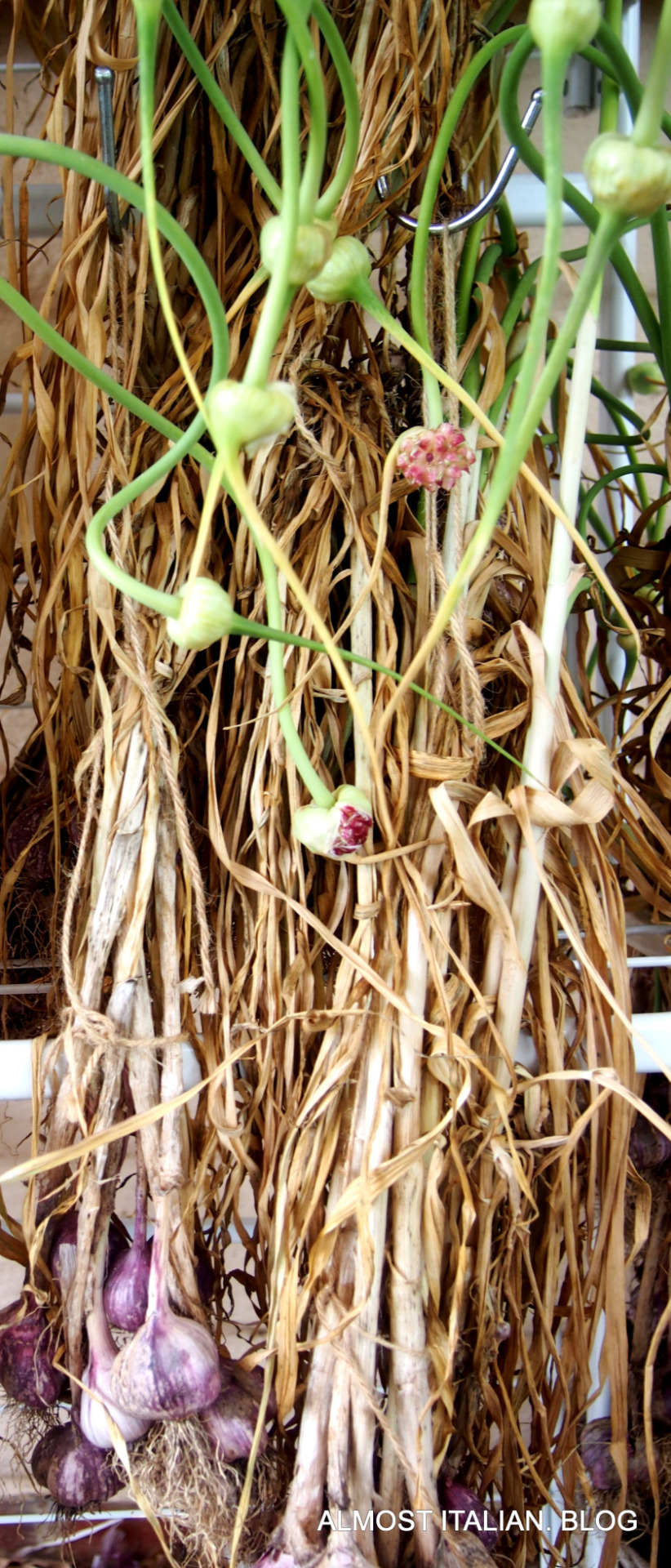
Garlic hangs to dry, pretty bulbils continue to form. Bulbils are not seed but can be used in the same way as cloves. They will take two to three years to mature into big bulbs.
After pulling the garlic, clean the bulbs as soon as possible. I use a damp cloth to remove dirt and baked on mud. It’s important to clean them before bunching and hanging as later cleaning is far more tedious and you don’t want to introduce any dampness to a perfectly dried garlic. Hang the garlic under an airy verandah, well protected from rain and harsh northern sun. They may take a few weeks to thoroughly dry and harden. Well cured garlic will store longer.

Ready to plait or store.
Storing
After drying, the fun begins. Rub away the outer skins and along the stem to reveal the clove shapes. Most of the dark purple papery skin disappears, revealing soft mauve and white underneath. You might like to plait a few if you have grown soft necked garlic. Most of my garlic stems are too hard to bend into plaits so I make a few nice bunches to display in the kitchen. The rest get cut and stored in a dark spot, usually in a close weaved covered basket, or a container that can breathe, or in a hessian sack inside a terracotta pot.
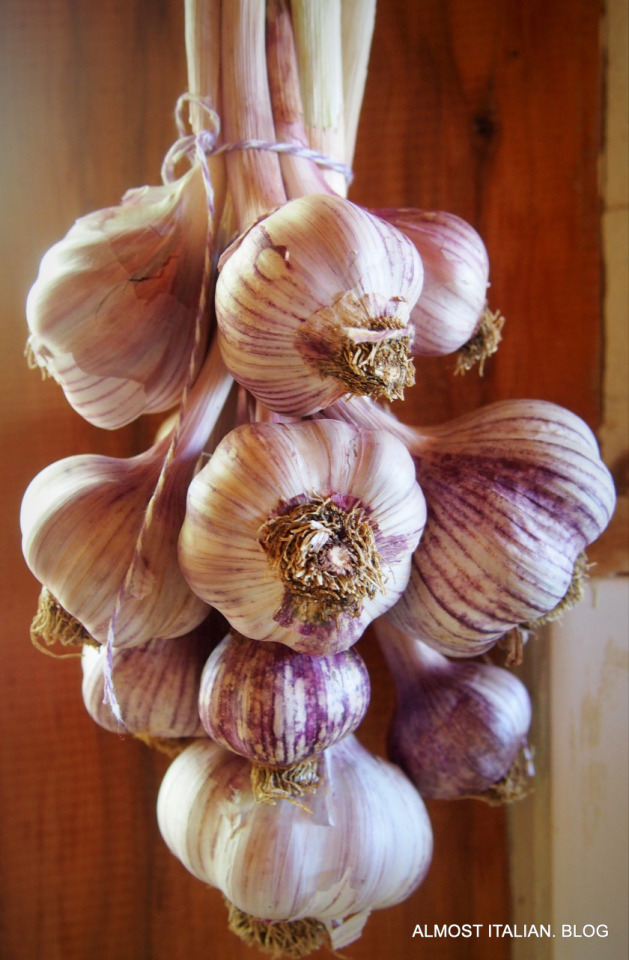
One bunch on display in the kitchen. Because they are hanging in full light, they’ll probably need using before next April. Well stored garlic should last much longer.
I’ve featured photos of bulbils in my header photo and throughout the post. Bulbils form when a scape is allowed to mature. The scape is the stalk growing out of a garlic bulb. Although it is sometimes called a ‘garlic flower’ it is not really a flower. Like cloves from a bulb, bulbils propagate garlic vegetatively and the bulbs that grow from them are clones of the parent plant. This year we found a mysterious bed full of excellent garlic that I definitely did not plant. I vaguely recall throwing around a few handfuls of bulbils around two years ago. During summer, they produced stems that looked more like chives. They grew under the shade of a rampant pumpkin vine. These chive like bunches developed, untouched, over two years, and turned into my star garlic for the year.
A few notes.
The medicinal properties of garlic are well-known. A short paper on the history of garlic used medicinally can be found in the link below.
https://www.ncbi.nlm.nih.gov/pmc/articles/PMC3249897/
But then the Italian contadini always knew this, as these old proverbs corroborate:
L’aglio è la farmacia dei contadini. Garlic is the peasant farmer’s pharmacy.
L’aglio è la spezieria dei contadini. The same as above. A ‘spezieria’ was a workshop – laboratory in ancient times where medicines were prepared by an apothecary. The monasteries were famous for their spezierie.

Bulbils broken into little gem like cloves.
How Does Your Garlic Grow Have you ever noticed the cost of organic garlic? Australian organic garlic retails for around $30 or more a kilo ( €20/US$22).
#aglio#bulbils#cloves#gardening#garlic#harvesting#medicinal#mulching#planting#seeds#vegetable gardening
0 notes
Text
Another Green Recipe from a Militant Gardener
Another Green Recipe from a Militant Gardener
The word ‘green’ is associated with more connotations than most other colours, including immaturity, rawness, naivety, pale and sickly looking, envy, and the green environmental and political movement, just to name a few. Perhaps some of these concepts are inadvertently connected? As an offshoot of the green environmental movement, some cooking sites loudly proclaim to be ‘green’ which has become…
View On WordPress
#blogging#broccoli calabrese#cavolo nero#Cucina italiana#Cucina Povera#food marketing#food myths#gardening#garlic#green food#green vegetables#greens#Italian#olive oil#pasta#self sufficiency#tree change#tree tories#vegetable gardening
0 notes
Text
The monthly series, In My Kitchen, has become my record of seasonality. As November’s green crops and broad beans slowly disappear from the garden, making way for December’s zucchini and early tomatoes, so our meals begin to change and the kitchen sings with new excess. The annual garlic crop has been harvested and is hanging out to dry for a month, though a few young specimens have made their way into the kitchen. Organic Australian garlic tastes superb: it has taken six months to mature in the garden and is then carefully cleaned, tied and hung for a few weeks to harden, then stripped of its outer casing. Some get plaited but most are stored in the dark for the season. This year’s harvest, over 300 bulbs, is a labour of love, enough to keep the vampires away.
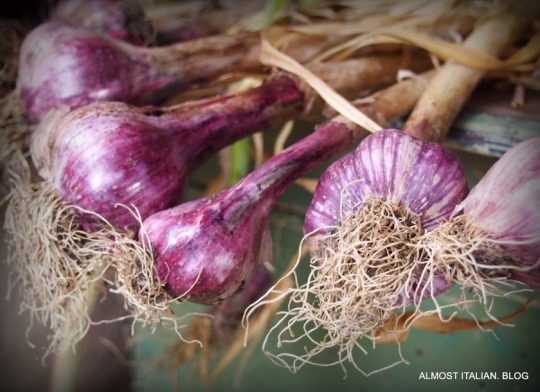
Christmas baking odours permeate my kitchen as dried fruits soak in brandy for a day or a week, followed by the slow baking of fruit cakes, evoking memories of an another time. It’s ironic to be dedicated to the Christmas traditions of the Northern hemisphere when our hot summer season brings such luscious and bountiful fresh fruits to the table. Our loganberries are in full flush, picking a kilo a day is enough at a time. The peaches are about to ripen while the netting of apples, nectarines and pears has come early this year. Meanwhile, the markets are full of mangoes, apricots and cherries. Lighter summer festive desserts based on summer fruits include Pavlova topped with mangoes and tropical fruit, alcohol laced trifles layered with berries and fresh peaches, or berry purée drizzled on anything at all, like yoghurt for breakfast, or vanilla ice cream for supper.
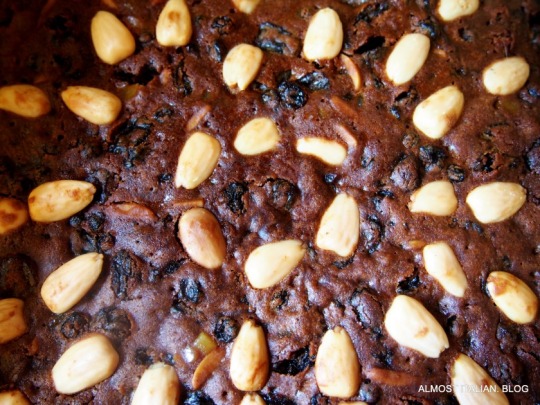
Cherries in season. My cherries were all eaten by the birds.
Another day, another kilo of berries.
The brandy bottle is kept nearby in the kitchen, for cooking purposes only.
First of the apricots
I’ve been expanding my sourdough recipe files lately, churning out new breads each week. Celia’s light rye was a favourite, followed by a heavier and darker rye from Breadtopia. I’ve worked on two fruit breads, a fig and fennel sourdough based on a recipe by Maurizio at the Perfect Loaf, and the other, a more economical raisin and fennel loaf. In between, I make my everyday sourdough loaves, using 20% wholemeal, also based on a recipe by Celia. I love the way my loaves take on individual characteristics when baking. Perfectly imperfect but always so tasty. One day, when my bread making routine didn’t coincide with our needs, I made a yeasted olive and rosemary loaf, based on a recipe by Maggie Beer, a quick 3 hour bread, unlike my slow 24 hour fermented breads. It;’s a good standby.
The Every day loaf.
profile of a fig and Fennel sourdough
Bread making gear
Yeasted olive and rosemary bread
Dark rye, studded with fennel and Anise seed.
Everyday loaves.

Churning out the loaves. Some with happy smiles and crispy ears, others with a snarl.
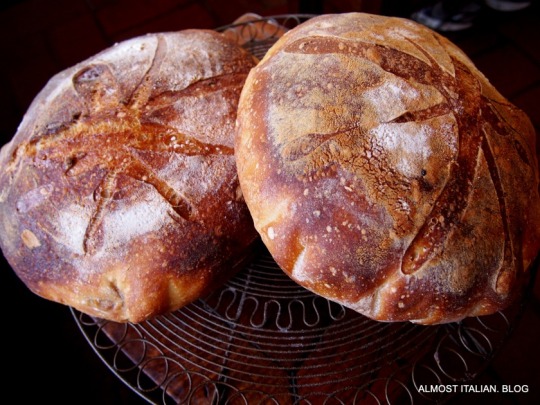
Looking a lot like Tam O’Shanters, the most delicious bread ever, the fig and fennel festive sourdough
This lovely bunch of roses arrived to dress my kitchen table a few weeks ago, courtesy of my dear friend Diane, a rose aficionado and dedicated gardener. Pierre de Ronsard is a joy to behold. Your immediate inclination is to sniff a rose, but Pierre De Ronsard is not known for its sweet perfume. Its romance lies in the shape and delicate colour. Each bloom is said to hold 400 petals. I am determined to grow this lovely climber next year. It is named after Pierre de Ronsard, a poet in the court of Mary Queen of Scots and a keen gardener. I love flowers throughout the house on benches and tables and window sills. There’s always something to pick and enjoy, even though it may not be as dramatic or gorgeous as Di’s roses.
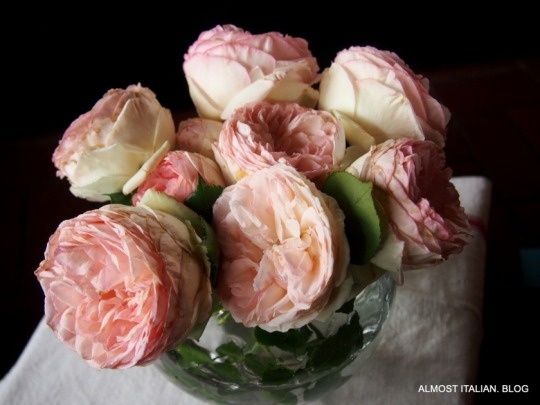
Pierre de Ronsard
Thanks once again to Sherry for hosting this series. You can read her funny Christmas post at Sherry’s Pickings, read other bloggers entries, or join in yourself.
And finally, I must mention a food related link this month- a thought-provoking article from The Angry Chef.
https://angry-chef.com/blog/the-modern-chef-s-guide-to-being-angry
And a few links to my December IMK posts from past years. Same same but different?
https://almostitalian.blog/2017/12/06/in-my-kitchen-december-2017/
https://almostitalian.blog/2016/12/02/in-my-indian-kitchen-december-2016/
https://almostitalian.blog/2015/12/01/in-my-kitchen-december-2015/
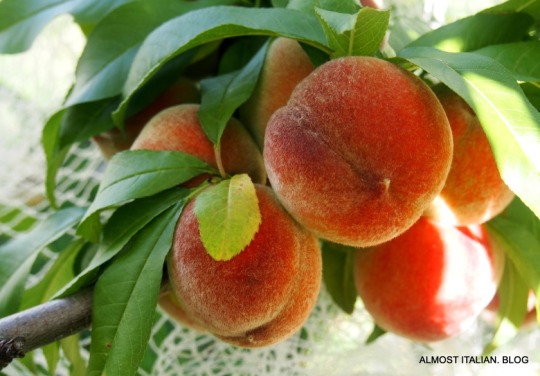
In My Kitchen, December 2018 The monthly series, In My Kitchen, has become my record of seasonality. As November's green crops and broad beans slowly disappear from the garden, making way for December's zucchini and early tomatoes, so our meals begin to change and the kitchen sings with new excess.
#berries#breadmaking#Christmas cake#culinary traditions#fruit growing#gardening#garlic#In My Kitchen#pavlova#roses#seasonality#sourdough#summer dessert#trifle
0 notes
Text
Spring Gardening and Green Recipes
Spring Gardening and Green Recipes
‘Eat your greens’ was a familiar reproach from the elders around my childhood dinner table, as the boiled beans lay listlessly on the plate at the end of a meal. My father tried to lighten the mood by inventing riddles to encourage or distract the young diners, “Beans were made for queens”, or rhymes about historical events. There was nothing appetising or appealing about cooked greens in the…
View On WordPress
#broadbeans#eggs#fava beans#gardening#greens#haloumi cheese#lemon.#mint#organic#silverbeet#Turkish#vegetable garden#Vegetarian
0 notes
Text
It’s around 5 pm and my mind reluctantly begins to address the question of dinner. Lacking inspiration, I pour myself a drink, an encouraging white wine and immediately think of risotto, a dish that asks if it may share some of the bottle. There are tons of broadbeans ( fava beans) and leeks in the garden and plenty of herbs: a risotto primaverile could be the answer. At other times, I do the common thing and google a few ingredients in the subject line, hoping for an instant answer, fully conscious of the fact that random internet recipes are unreliable and are simply another form of procrastination. I often ask Mr T what he would you like for dinner. In our household the answer always comes back as a one word statement indicating a particular ethnic cuisine. “What about some Indian?” (or Thai, Italian, Greek, Middle Eastern, French, Indonesian, Malaysian, Chinese, Japanese)? he responds. Vietnamese is off my cooking list- I save that cuisine for at least one economical dining option when out and about. When Melburnians eat, they choose from a huge array of influences and are familiar enough with many cuisines to cook them confidently in their own kitchens.
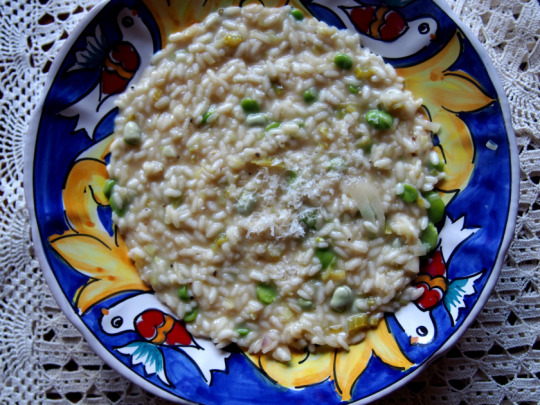
Risotto Primaverile. Inspired by spring vegetables and white wine and of course, Italy.
It’s one of the reasons I love Melbourne so much. Sitting in the A1 Bakery yesterday, a cheap and cheerful Lebanese restaurant in a vibrant inner suburb, we were surrounded by Australian people of the world, dressed in all manner of clothing styles, from Hijab to Hipster. The decor is eclectic and a little quirky. Above the counter stands a large statue of the Virgin Mary, draped in all her blue and white Catholic glory, an outfit not dissimilar to that worn by some of the customers, while displayed in front of her is a long row of 1 metre high golden hookahs. An odd assortment of pictures decorate the far walls:- a primitive painting of Ned Kelly, the Irish- Australian bushranger legendary hero, an oil painting of Saint Sharbel, a Lebanese Maronite saint dressed in brown monastic garb, a large velvet rug featuring some knife wielding Ottoman Cossacks, and a childlike painting of a cockatoo. The place is always noisy and very busy. On a nearby table, a large group of girls are enjoying a shared lunch together: they have just finished their final year school exams and are celebrating at one of Melbourne’s most affordable eateries. They are Middle Eastern, Turkish, African and Asian Australians. A couple wear glamourously draped head-dress over their teenage uniform of jeans and t-shirts. They speak Melburnian – time to recognise that Australian English has many distinct dialects – and their youthful laughter is infectious.
Below, my home-made falafel, this time with more Egyptian influence and lots of herbs.
My next door neighbour in the city has just returned from her annual holiday in Greece. For the last 22 years she has tried to teach me basic Greek. We chat in a mixture of broken English and, in my case, almost non-existent Greek – a case of trying to recognise as many Greek roots and suffixes or Italian sounding words, over a some warm Tiropsomo, a fetta cheese bread snack. Like a little bit of Ouzo, says Anna at any time of the day. Oooh, my favourite Greek word: yes please. She pours herself a thimble full while I receive a good little glass, enough to change the flavour of the day. Cheers, Stin ygiasou . She is now 86 and I want to spend more time in her kitchen. Greek influence in my kitchen extends to old favourites such as Spanakopita, that famous greens and fetta pie, Gigantes, the best of bean dishes, home-made taramsalada and dolmades. I’m keen to learn a few more Greek tricks.

Crostini with smashed broad beans and Greek Fetta. Italy meets Greece via Sicily often in Melbourne. Pick one kilo of broadbeans ( fava), shell them, coil for one minute then remove tough outer casings, mix and smash, season well. Top grilled sourdough with mixture, then add some crumbled sheep fetta, olive oil and mint leaves.
The annual Spring BBQ at Barnardi’s place took place recently: this is one of the culinary highlights of my year. When I arrive at most parties, I usually reach for a glass of wine before perusing the food offerings. At Barnadi’s, I head straight to the buffet table- the anticipation of his traditional Indonesian food is so overwhelming, I become outrageously greedy. Barnadi is a chef who once ran a famous Indonesian restaurant, Djakarta. Lately, he has returned to his roots and is cooking more traditional Indonesian recipes. The Australians attending this event all share a diverse background, Indonesian, Thai, British, Greek Italian and Swedish, a healthy Melburnian blend. The dessert table included a tray of sticky rice green and pink Indonesian cakes, some Javanese Gembong, a rich Spanish flan, a chocolate cheesecake and a Hummingbird cake for Adam’s birthday.
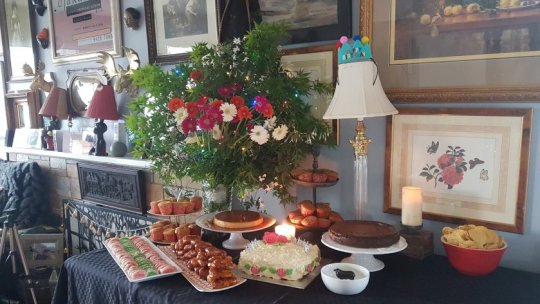
Barnadi’s sweet creations, photo courtesy of Adam. The long dish second from the left contains Gembong, my favourite Javanese sweet, sold in streets of Cipanas, West Java.
Indonesian spread
My mother recently moved into an elderly care facility, commonly known as ‘the place’. The first thing we checked out was the menu. The food is fabulous and varied: the chef, who once had his own restaurant and is of Indian Fijian background, has a great approach to the menu. He hopes to eat this well when he is elderly and so he cooks as if he were a guest the table. Yes, it’s Karma, we both agree. Visitors can eat with the residents with notice, and there’s always a spare dessert available when visiting during meal times. They are sensational. Each member of staff, from manager to cleaner, is genuinely caring and friendly: they smile, dance and chat to all. These Aussies have Chinese, Malaysian, and Filipino backgrounds and I am so thankful for their loving care of my mother.
I’ll leave you with some a couple of my favourite comedy clips, each with a Multi Cultural message. Half a laugh or a cringe. Thanks Sherry, from Sherry’s Pickings, for hosting this monthly series.
youtube
youtube
In My Kitchen, November 2018 It's around 5 pm and my mind reluctantly begins to address the question of dinner. Lacking inspiration, I pour myself a drink, an encouraging white wine and immediately think of risotto, a dish that asks if it may share some of the bottle.
#Australia#Australian cuisine#broadbeans#comedy#Egyptian- australians#falafel#fava#fetta cheese#Greek cuisine#In My Kitcehn#Indonesian#Lebanese#Melbourne A! Bakery#migrants#risotto
0 notes
Text
Pantacce, the Wonder Pasta and Lentil Soup
Pantacce, the Wonder Pasta and Lentil Soup
Pantacce pasta is my new favourite shape. I’ve mentioned this shape before in my occasional Pasta of the Week series. Made by Molisana, another company using the bronze die extraction method ( look for the words trafilatura al bronzo on the pasta packet), it is a comforting shape and texture ideal for hearty soups, resembling maltagliati but more regular in shape.

pasta pantacce
The following…
View On WordPress
#bronze dies#comfort food#EV olive oil#italo-australiani#lentils#Molisana pasta#pantacce#parmesan#pasta#recipe#Soup#Stefano de Piero#tomato vegan#Vegetarian
0 notes
Text
There is a calm urgency about my mornings in Bali. I’m keen to arrive at the beach a little before 6 am, drawn by the dawn but also by the anticipation of catching a sighting of Mt Agung on the horizon. When Guning Agung is in hiding, I admit I’m disappointed, and move along with my day a little more quickly.

Gunung Agung
I head along the beach pathway in the direction of the cake lady’s stall on the brick wall at Pantai Sindhu. You have to be early to buy her freshly made Dadar Gulung. All her special cakes have been snapped up by 7am. She is round and sweet, just like her cakes and greets me with Selamat Datang if I’ve been away for a while. If it’s her day off or if she has ceremony, I wander down the road to the Sindhu market to buy cakes there, along with a hand of bananas or a few mangoes. Indonesian cakes are light and sweet, and incorporate three main ingredients- sticky rice, coconut and coconut palm sugar,and come in an endless array of shapes, colours and textures. They are boiled, steamed, baked or fried, often enclosing a secret ooze of bean or palm syrup and are small enough to wolf down in two bites. I’m very fond of green cakes, a colour extracted from the Pandanus leaf and striped jelly cakes made from agar-agar.

Today’s surprise package from a new lady at Pasar Sindhu. A triangular parcel, made from banana leaf, filled with a sweet mixture of black long grain sticky rice, boiled jaja, shredded fresh coconut and a generous drizzle pf coconut palm sugar syrup. I did not share this wonderful concoction with anyone.

Yesterday’s Pasar Sindhu was alive and more frantic than usual. By 6 am, motorbikes and trucks had filled the small carpark entrance. Something was going on and I had to find out. The rows were crowded with vendors of cakes, ceremonial nic nacs, chicken stalls and flowers: I could sense excitement and frenzy, that buzz that permeates markets before a big festivity, akin to the mad rush in Melbourne markets before Easter or Christmas. I sought out my friend Ketut: she runs a little kitchen ware stall at Pasar Sindhu and is a goldmine of information. Today, she informed me, was Tumpek Wayang.
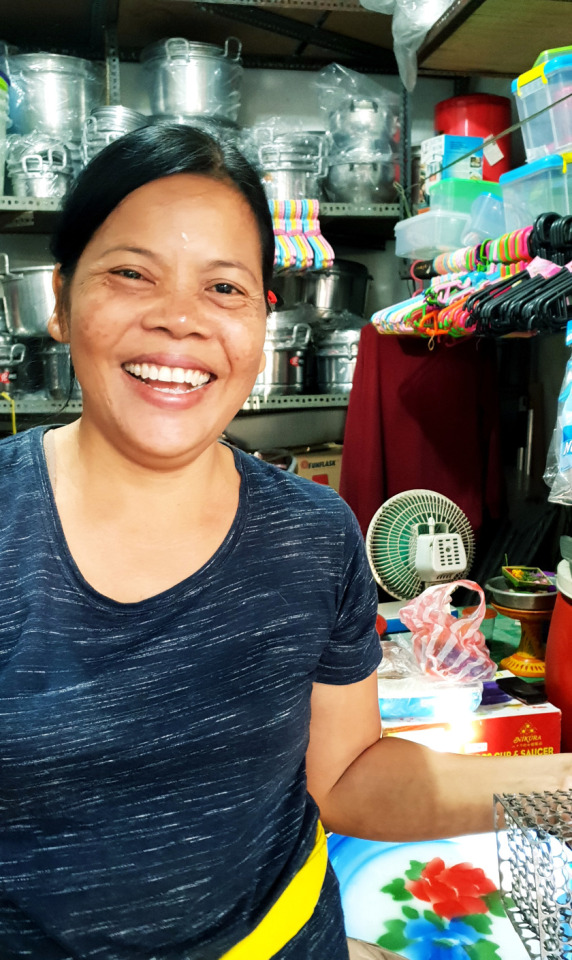
Ketut’s shop, Sindhu Market.
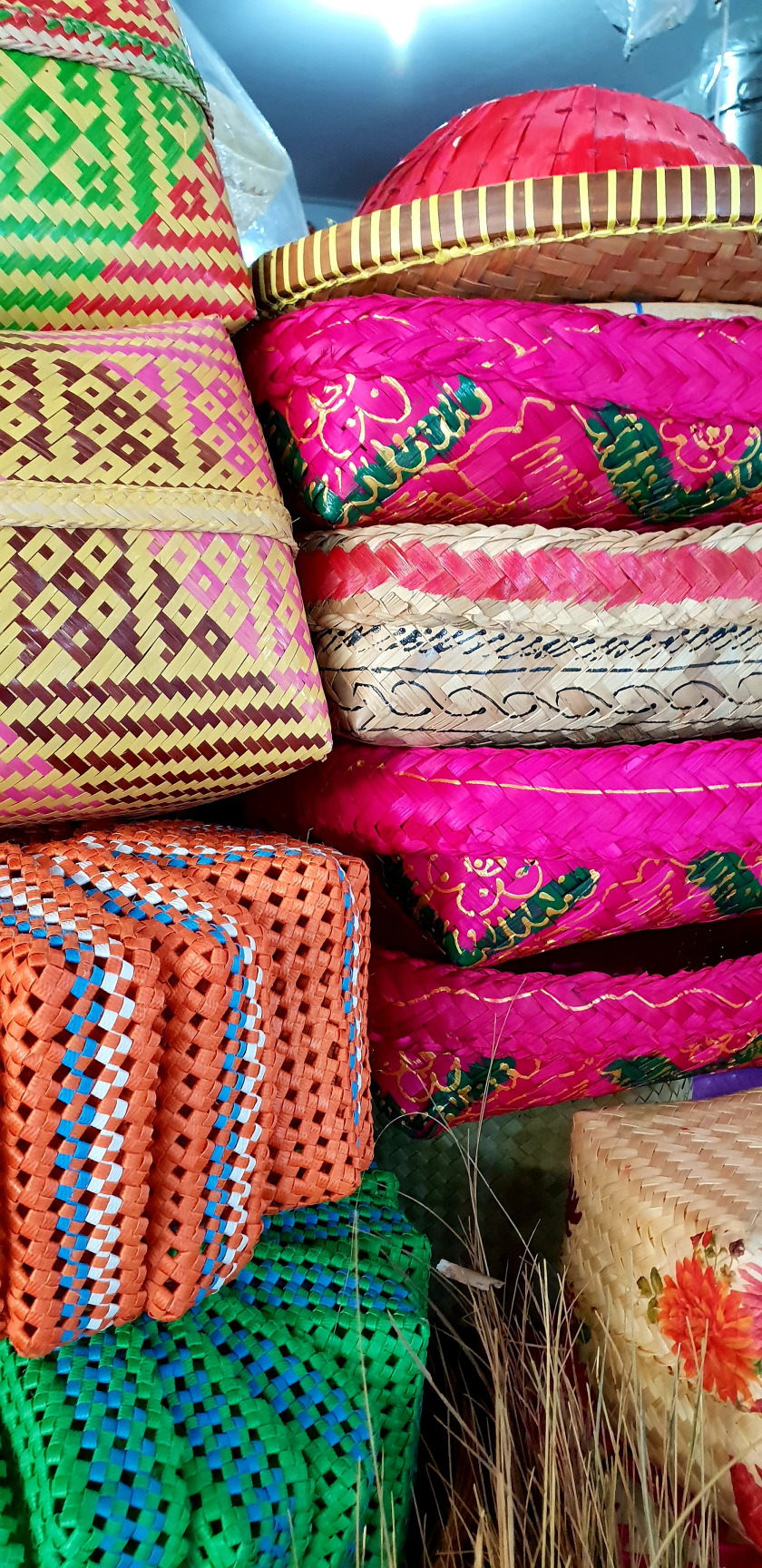
Ceremonial Baskets, Sindhu Market
When Ketut mentioned Wayang, or puppets, I almost ran home to my books and internet, keen to find out more about the day and the ceremonies that would follow. Along the footpath and business doorways of Jalan Danau Tamblingan, I almost tripped over the elabourate displays of Canang Sari. Today’s floral offerings were completely different, much bigger than the usual little baskets, with rectangular bedding of palm leaves and another jagged edged leaf, as well as flowers. Each business had the same leafy arrangement- another mystery to uncode.
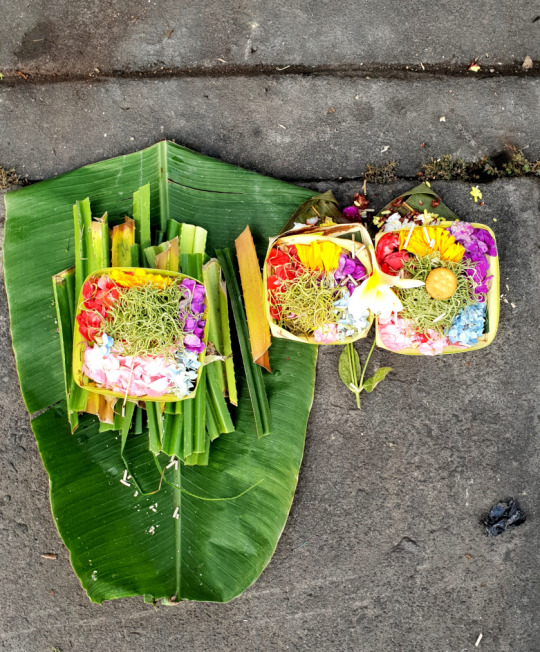
Tumpek Wayang, occurring every six months, is a festival when puppeteers perform purification rites to purify their bodies both physically and mentally. It is also a day of the performing arts, when offerings may be made to musical instruments and dance equipment. On this day, puppeteers (Dalang) throughout the island will present offerings to their shadow puppets (wayang kulit) with the intention of honouring the Lord Iswara. The puppets are taken out from their cases to be blessed by their owners and placed as if an actual performance is being held. This ceremony is staged at the different temples, and is titled Sapuh Leger. In short, this is the day of puppeters and the puppets themselves.
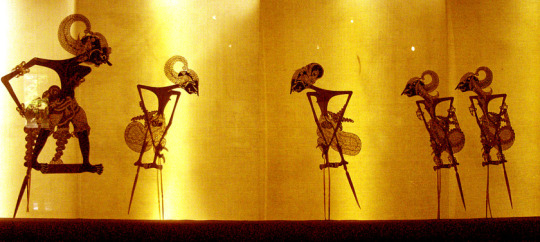
I have profound memories of the puppeteers and Balinese shadow plays, Wayang Kulit, of old Bali. On our first trip to Bali in 1979, travelling then with two young children, aged 9 and 7, we set out at dusk on a horse and cart into the countryside to see this famous shadow play. The night was dark, no street lighting or electric lighting of any kind lit the streets or houses back then. The village was lit by kerosene lamps. On that occasion, we were the only Westerners in the village. Fortunately we were met by the local schoolteacher. He spoke English and kindly offered us some tea and green cakes – my love of Indonesian cakes began on that day. The Wayang Kulit stage was raised and broad, covered in a long stretched white sheet and back-lit by a flickering lamp. The exotic sounds of the gamelan orchestra tinkled through the night, as hundreds of villagers sat below the stage in the dark and watched in awe. We took our place in the audience as the puppets performed the Ramayana, a show that lasts for 6 hours or more,as we soon found out. At some point we realised that we needed to exit gracefully: carrying our sleepy children, we managed to find a horse and cart to take us back to our palm thatched losmen.

Today’s Tumpek Wayang celebrations were in full swing by mid afternoon. As the amplified voice of the puppet master, exaggerated, theatrical, emanated loudly from nearby temple, I wondered whether the voice I heard was that of a real working Dalang or a recording: there aren’t so many working Dalangs in Bali these days, ( in 1990 there were around 2-300 Dalangs but only 30 working Dalangs ¹) not because of any demise in tradition, but because the role of Dalang is a demanding one, requiring skill in story telling, improvisation, comedy, linguistic skill, religion, singing, music, orchestra direction, puppet making as well as stamina.
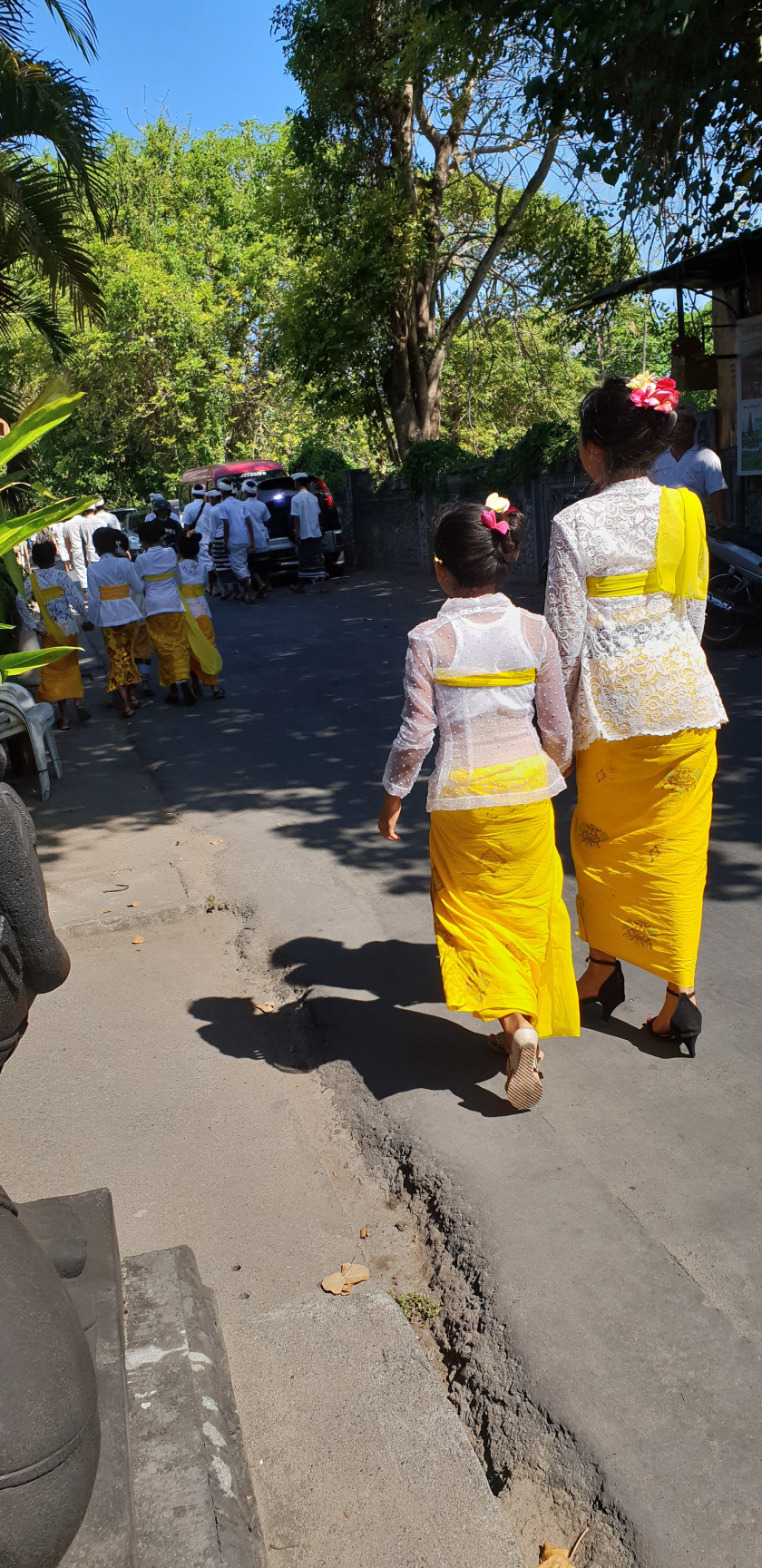
As food stalls began to line the streets, groups slowly gathered, dressed in white and gold, the colours of purity, and walked towards the temple for the ceremony, due to start at 4.30 pm.
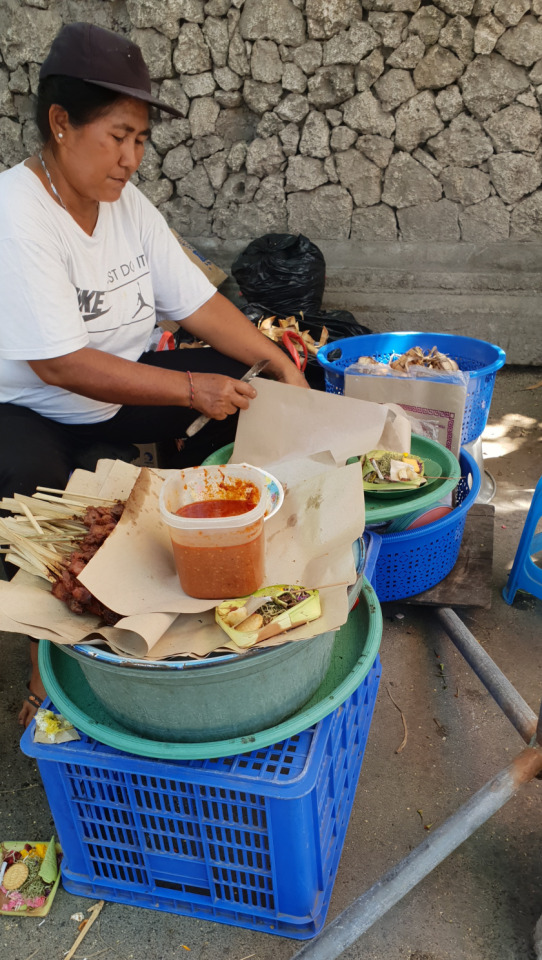
Most days go like this Bali. After 40 years of visiting, I’m still trying to fathom the mysteries and joys of Balinese Hinduism. Sunrise to sunset and the time in between may bring an afternoon ceremony, a seaside cremation, or a purification ritual. Read the signs and keep your senses alert to gongs, bells and gamelan, then ask the locals about the the day’s events. If you wish to join in, or visit any temple or ceremony, you’ll need the right outfit- a top with sleeves, a traditional printed cotton sarong and a scarf tied around the waist. While Balinese women tend to wear a lace kabaya, it is acceptable for westerners to wear any other sleeved shirt or T-shirt. Balinese men go for the double sarong on ceremonial days and look extremely dashing. Western men need only learn to tie their sarong in the appropriate way, worn over shorts.

¹ For further reading on Balinese ceremony and culture, see Bali, Sekala &Niskala, Essays on Religion, Ritual and Art. Fred B. Eiseman, Jr. Tuttle Publishing 1990. A remarkable book and a must for lovers of Balinese culture.
Another Day Unfolds in Bali. There is a calm urgency about my mornings in Bali. I’m keen to arrive at the beach a little before 6 am, drawn by the dawn but also by the anticipation of catching a sighting of Mt Agung on the horizon.
#Bali#Balinese cakes#ceremony#Dalang#Gunung Agung#hindu temples#Hinduism#Indonesia#Indonesian culture#Indonesian puppets#Pasar Sindhu#Ramayana#ritual#Sanur#sarong#Tumpek Wayang#Wayang Kulit
0 notes
Text
Morning of the World: Balinese Dawn.
Morning of the World: Balinese Dawn.

Quietly Gunung Agung waits.

The Sanur sea platforms are used for silent reflection, yoga, photography and lovers.

Ohm

Jukung glows copper at dawn.
View On WordPress
0 notes
Text
As some parts of Bali becomes more urban, the importance of enclosed green spaces and lush tropical gardens becomes paramount. Finding accommodation within a well established, older garden is one of my priorities when staying here. There are many well tended gardens around Sanur, a beach suburb of Denpasar: some are grand in size, others small but inviting. They are usually found in the grounds of older and more traditional Balinese hotels. Gardens are tended daily: the role of the local gardener is one of utmost importance. They are up at first light, sweeping paths and removing fallen leaves. I rise with them, and gather the fallen frangipani blossom ( Jepun in Balinese) before they are swept up. Each day a new fall brings a different coloured blossom, some deep yellow tinted with maroon and pink, others creamy white, or pure yellow.
Later the gardeners prune and shape fecund vines, removing spent branches from palms, separating some for new plantings, or trimming unruly hedges. They work silently, usually with simple hand tools, clippers, scythes and knives. Tropical growth demands constant attention. I’ve always been keen to copy some of these elements in my garden in Australia, a harsh environment cursed by wind and fierce heat in summer and frost in winter. The key element I would like to emulate is infrastructure. Walls feature often throughout Balinese gardens, along with doorways, small pavilions, pathways, and statues. Plain brick or concrete walls provide protection from the wind, shade and a structure for climbing plants. An ugly wall is soon softened with foreground planting. and climbers.
Other elements of a Balinese Garden are worth noting. Small spaces, even in a terraced back yard or balcony, can be turned Balinese through selecting some of the elements that suit your space.
Gates. Decorative gateways are common features. They provide a focal point or lead the eye to some feature in the distance.in the distance. Various styles of gates are used, but the most evocative are intricately carved. They make perfect supports for climbers such as Bougainvillea and other climbers.
Paths. Often different paving materials are combined to create decorative effects. Note that things are not perfectly symmetrical or edged too thoroughly. A little randomness is part of the Balinese appeal. A formal garden is often followed by a very natural and organic corner.
Statues . Statues of people, animals, religious and mythical figures. Balinese statues are often carved out of stone and can be seen in the thousand in the carving villages along the main road from Denpasar to Ubud. Here in Bali, statues, walls and gates age quickly. The tropical environment antiques walls, statues and pots rather quickly.
Water. Ponds and fountains are common in Balinese gardens, a place to grow lotus and other water leafy plants.
Pavilions. Roofed and open sided with a raised floor, a shady pavilion is an inviting spot for an afternoon read or a place to reflect.
Plants. The indigenous plants of Bali have been mixed with introduced species for over 1,000 years. Palms, tropical fruits and large Banyan trees give shade and height while lower growing plants including Ginger and Hibiscus provide colour. Plants are often grown in decorative containers to create features, especially different coloured Bougainvillea which are kept well pruned. The aim is to create height and layers of growth, as well as open grassy areas for contrast.
Roots of ancient tree.
nn
For Peter D, tropical gardener in Far North Queensland, who could name all of these plants, and Helen and Rosalie, who also love a good traditional garden space in Bali. And also for my wall building son, Jack, who might have some time to add some garden infrastructure on his return from Bali. Ohm.
Nangka or Jackfruit, carefully tended in a nearby garden.
Living and Loving in a Balinese Garden As some parts of Bali becomes more urban, the importance of enclosed green spaces and lush tropical gardens becomes paramount.
#Bali#Balinese gardens#garden#gardeners#Indonesia#infrastructure#lotus#pavilions#Sanur#tropical gardens#water features
0 notes
Text
Sanur, Bali. Food to Nourish a Jaded Soul.
Sanur, Bali. Food to Nourish a Jaded Soul.
Sunday Greetings from Sanur, Bali. Today’s post is simply about food. No spiritual anecdotes, or canang sari, moody sunrises or colourful Balinese characters. Just a picture post tempting you with some earthly delights eaten under a shady umbrella in a simple warung by the sea.
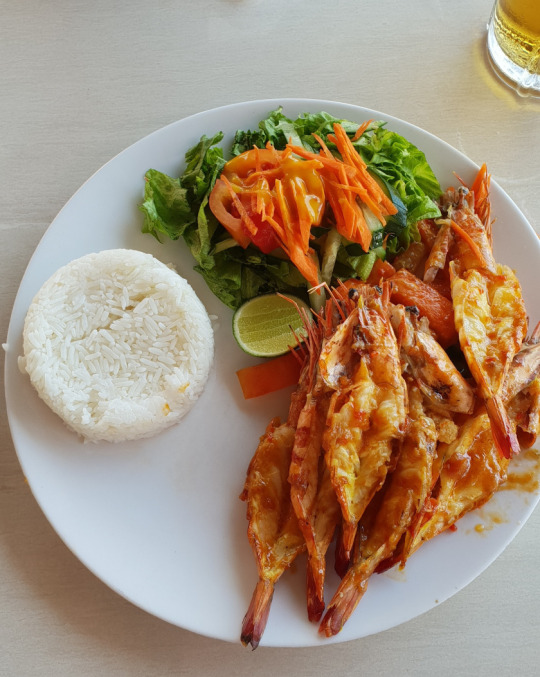
The best grilled prawns ever. AU$6/ Warung Odah Oning, Pantai Semawang, Sanur, Bali
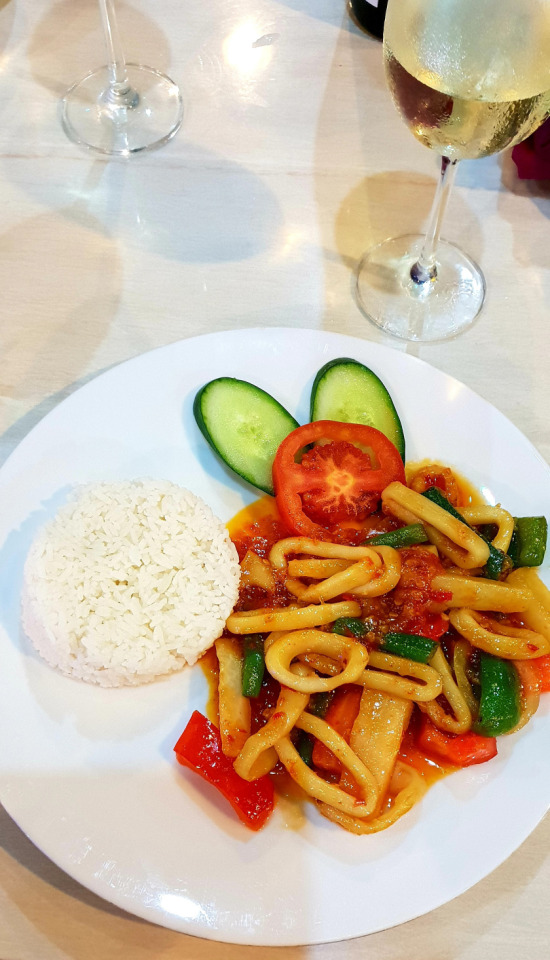
Cumi Pedas- a chilli hot stir fry…
View On WordPress
#Bali#beach warung#cumi pedas#dadar gulung#Jepun restaurant#Odah Oning#prawns#salak#Sanur#sate lillit#Semawang#snake fruit#squid#udang
0 notes
Text
Pasta of the week: Pizzoccheri della Valtellina
Pasta of the week: Pizzoccheri della Valtellina
One of my favourite winter pasta dishes is Pizzoccheri della Valtellina. The combination of buckwheat pasta, savoy cabbage or other greens, with fontina cheese and a buttery garlic sauce is so comforting and nourishing on a cold day. I bought some buckwheat flour recently, fully intending to make my own buckwheat tagliatelle but then I heard a little voice whisper, ”Don’t create a rod for your…
View On WordPress
#buckweheat#cavolo nero#chard#comfort food#Cucina italiana#fontina cheese#Italy#Lombardy#Northern Italy#parmesan#pasta#pasta of the week#Pizzoccheri della Valtellina#Savoy cabbage#silverbeet#winter
0 notes
Text
In My Kitchen, September 2018
In My Kitchen, September 2018
A few years ago, an old friend mentioned that he found my blog very positive. Since that day, I decided to keep it that way. There’s enough negativity in the world without me adding my two bob’s worth concerning the sadness of our times, family illness and the winter of my discontent: in times like these, graceful silence makes more sense. And so I raise my glass to Spring, and though the…
View On WordPress
#Botticelli#Camino#capesante#Coquilles st Jacques#Galicia#Herbal Tussie Mussie#herbs#legends of st james#lotus tea#pilgrimage#saffron#Santiago di Compostella#scallops#Venus
0 notes
Text
Bali, Tradition and Change. Witti's Story
Bali, Tradition and Change. Witti’s Story
It was the sign on the little Warung that first caught my eye. The first item, Tipat Tahu Kantok, provided only one clue- Tahu (tofu) but the other elements remained a mystery. This was one Balinese dish I hadn’t come across before.
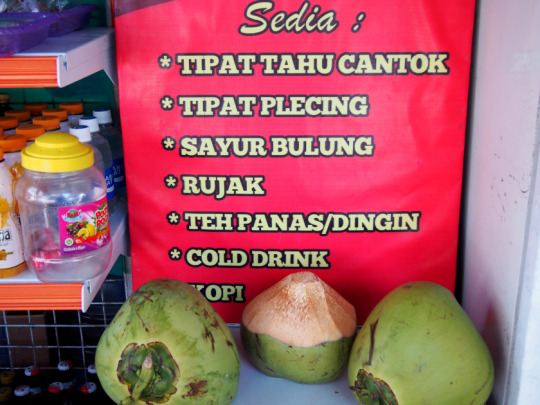
I asked the gentle faced man standing near the warung about the word Tipatand he pointed out some little palm leaf baskets hanging inside the Warung. Obviously,…
View On WordPress
#Bali#Balinese cuisine#earthquake#Indonesia#Mt Agung#Sanur#tipat#tradition and change#Volcano#warung
0 notes
Text
Designer Clothing Outlet in Sanur, Bali.
Designer Clothing Outlet in Sanur, Bali.
This post is about a special clothing designer store in Sanur Bali, but it is also my tribute to Sarina, a modern Balinese woman, who is full of beans. She is humourous, intelligent, worldly and an assertive feminist. The real Bali reveals itself through continued conversation and friendships made over the years and I enjoy re-visiting Sarina annually.
A trip to Sanur, Bali would not be complete…
View On WordPress
0 notes
Text
Food, glorious food, glorious Balinese food. It’s one of the reasons I keep returning to this beautiful island. Good Balinese food is seductive yet quite subtle. Two famous Balinese sambals, sambal matah and sambal merah, add depth to a simple grilled fish or chicken, while the combination of white pepper and coriander seeds, turmeric and galangal, purple shallot, lemongrass, palm sugar, chilli, and terasi ( fish paste) are pounded together to make a rich tasting bumbu, or Balinese spice paste, the basis for a simple curry.

Warung in the Sindhu Night Market
There are many tiers of eating establishments, or rumah makan, in Bali: you can pay a fortune at an upmarket international hotel, continuing to eat the cuisine from your home country, or a watered down version of local cuisine in a Western style restaurant, or you can try a more authentic and economical meal at a simple warung. A warung is a small family owned eating place, often located on the street or beach. Some may look a little ramshackle and temporary, often with small benches and plastic stools, and will be usually be patronised by locals. Other modern warungs have sprung up in the beach suburbs around Sanur, but some bear no relationship to the real thing.
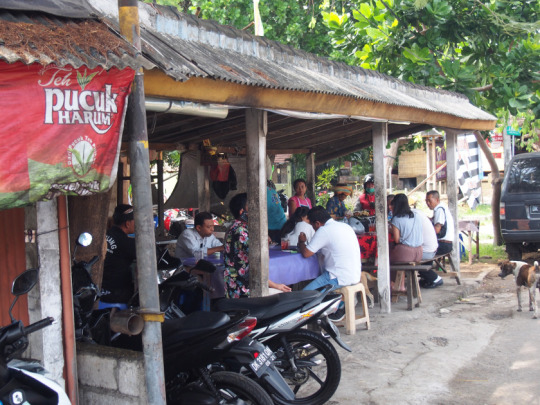
Many warungs are made from wooden, bamboo or thatched materials, perhaps with tin walls. In the past, the Warung tenda, a portable warung that looked like a tent, was more common, with roofing and walls made from Chinese blue and white plastic tarps. Other interesting warungs include kitchen carts on wheels, colourful bright blue Bakso stalls, motorbikes with gas cookers, and night market warungs set up with little tables and chairs. Warungs also tend to specialise in one or two dishes which are often based on a secret family recipe.
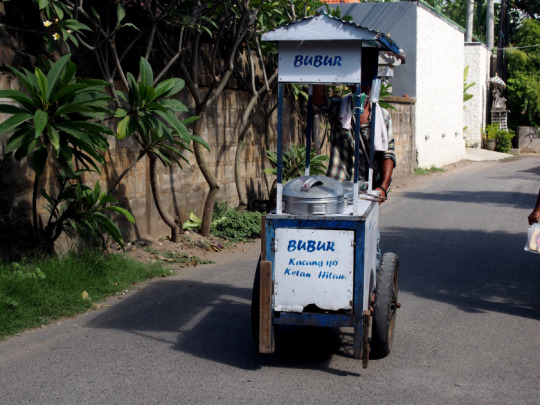
Morning bubur cart travels around the back suburban streets of Sanur, sounding a morning bell. Rice porridge comes with tasty toppings like ground peanuts.
I’ll admit It takes a brave heart to venture into the tasty world of the street warung: you need to assess the cleanliness of these eateries and often that’s quite hard. Word of mouth, and popularity with locals- these are all good indicators. Also check out the washing up facilities and water used. Good warungs are clean as hundreds of locals eat here every day. You may need to know a few food words, and simple phrases if you have special dietary preferences as often there’s no menu or price. ‘Tanpa daging ( without meat) or tidak daging ( not meat) will suffice if you don’t eat meat. As food is often cooked to order, a warung cook is happy to adjust a recipe for you, leaving out ingredients that you don’t like.
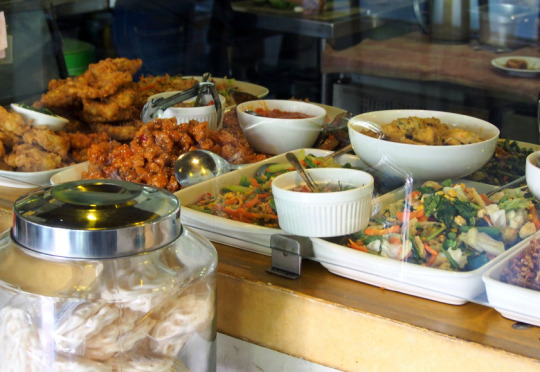
Modern take on Nasi Campur
Not all warungs are cheap: a few located around the Sanur beaches have become famous, rating highly on TA and frequented more by tourists than locals. One popular grilled fish restaurant, Amphibia, operates flat-out from midday till late. They work from a small tin shed, and grill the fish and seafood on anoutside charcoal BBQ. Bench seating is nearby. You order your fish, lobster, prawns, octopus, squid and clams by weight, then they are barbecued and served with rice and vegetable urab and sambal. These boys never stop. They buy the fish early in the morning at Jimbaran, then store it under ice in large tanks: during lulls in business, you can watch them tenderising and peeling octopus, cleaning prawns and fish, running hoses around the place and stoking the BBQ with charcoal. A share plate of snapper, prawn, shrimp, a few calamari rings and razor clams is AU$20. Sit on a little stool on the beach and share the platter with a large Bintang.

Hot work. Cooking at Amphibia. Sindhu Beach, Bali
Another Warung favoured by Westerners is Jackfish, a family run business right on the beach just past Semawang. Nyoman, the brains behind this warung, trained as a mechanical engineer but after working off shore for years, decided to open a fish themed Warung. His mother serves and makes the Urab (gentle tasting Balinese salad made from bean shoots, green beans and coconut). His father sorts cultlery and helps with the accounts. Nyoman does the grilling, waiting on tables and everything else. The family come from five generations of fishermen, and now source their daily deliveries from local sources. They often cater for large parties so check before hand as Jackfish closes when they do large groups. When I’m staying in the Semawang end of Sanur, I eat at Jackfish everyday, it’s that good.
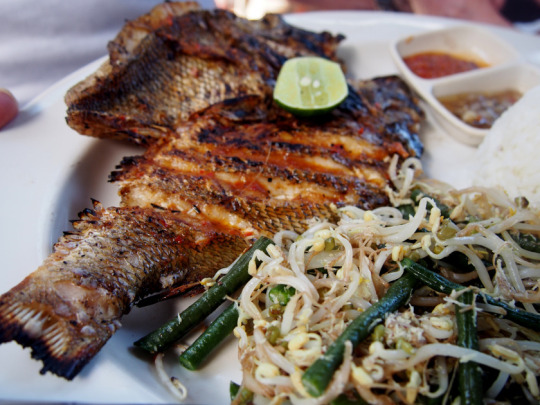
Grilled snapper, rice, urab, and two sambals. IDR 60,000/AU $6. Jackfish is located right on the sand at the Southern end of Sanur.

Energetic Nyoman of Jackfish, Semawang Beach, Sanur, Bali
When in the mood for snacks, I head for warungs specialising in deep-fried foods, called Gorengun. At these little carts you’ll find feep fried springrolls, deep-fried tofu or Tahu Isi ( Tofu stuffed with bean shoots) and battered gado-gado and other things with tofu, as well as an array of sweets such as Onde-Onde. A bag of 8 snacks will cost around $1 and comes with a few green chillies and chilli sauce.
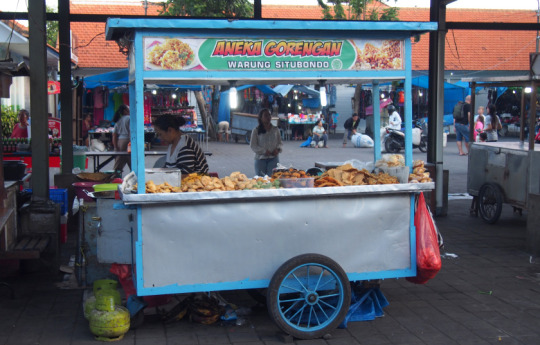
Tasty deep-fried vegetarian snacks from a Gorengan cart at the Sindhu Nightmarket, where a $1 goes a long way.
The Warung situated right in front of the Bunjar Pantai Semawang, has a great ocean view and is well sheltered from the wind. They do the best spring rolls in the district. Three large vegetable lumpia ( AU 1.50) make a tasty lunchtime snack. Try with a mug of hot lemon tea ( AU.65c) a fresh juice ( AU 1.50) or cut straight to the chase with a chilled Bintang to them down.
SatuBintangbesar, duagelas, TerimaKasih.
Balinese Cuisine at the Warung. Food, glorious food, glorious Balinese food. It's one of the reasons I keep returning to this beautiful island.
#Amphibia#Bali#Balinese cuisine#Balinese culture#banjar#budget travel#bumbu#gorengun#Indonesia#Jackfish#Sanur#semawang beach#sindhu beach#snacks#spices#street food#traditional#Travel#warung
0 notes
Text
Bali, Offerings and Squirrels
Bali, Offerings and Squirrels
Canang Sariofferings are well-known symbols of Bali, but alongside these daily Hindu offerings to the Gods, other older traditions remain in place. Ancestor worship and animist beliefs are sometimes separate from the cosmos of Hinduism, or are incorporated into it. Offerings of cigarettes, biscuits, coffee and alcohol are commonly seen on these shrines, things you might need in the afterlife.…
View On WordPress
#ancestor worship#Bali#Balinese Spiritualism#canang sari#Hinduism#Indonesia#offerings#plantain squirrel#Travel
0 notes